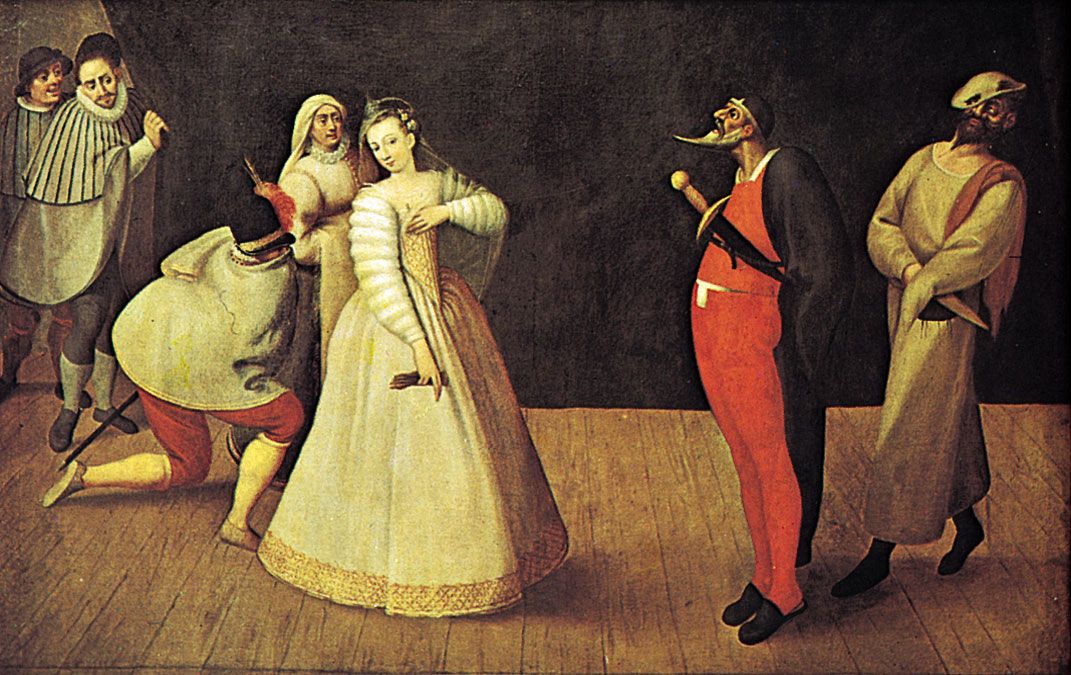by Jon Cranny – stage director for Il Tirinto
As with much of western culture, it started with the Greeks – comic drama, commedia. But alas only fragments of the Greek comedies survive. We know, however, that the Romans developed the form into a significant art form. And the comic drama they invented has served ever since as inspiration and fodder for comedy even up until our times.
When the Roman Empire dissolved and the Church came to an overpowering force, frivolities such as comic drama were band and forbidden. It was not until over a thousand years later that, at the behest of the Church, what we know as drama re-emerged and became a major factor in the Renaissance of art and culture. During the “dark ages” there surely were popular amusements and court entertainments. But they were not written texts.
Emerging in the 16th century in Italy was a form of improvised plays by bands of traveling professional players. It was known as Commedia dell’arte – Comedy of Craft, in a rough translation. The Commedia was influence by Roman comedy with stock characters improvising the dialog and stage business from a story known as a scenario. These stories were created by the companies and for the most part handed down verbally from older members of the company to the younger or newer members. It was not until well into the 17th century that many of these scenarios were written down and published. What is important to recognize is that each actor in the company specialized in a character type.
The characters in Commedia dell’arte can be summarized as follows: “two vecchi (old men), four innamorati (two male and two female lovers), two zanni (an astute servant and trickster), a captain and a servetta (serving maid)”. Looking ahead to our opera, Il Tirinto, you will recognize most these “types” in the cast of characters.
The stories were played outdoors on some kind of raised platform for the most part. Plot lines were developed on themes of love, courtship, jealousy, and the struggles between old age and youth. Often there was mistaken identity. These elements had informed the comic theatre for ages. Not long after Pasquini’s time, Carlo Goldoni wrote many plays which used the Commedia characters and even plots, basing most of his plays on old Roman comedies. Several of Goldoni’s plays continued to be presented in European and American theatres to this day. And a couple of years ago a new play was produced by the National Theatre in England, One Man Two Govnors, by Richard Bean. It is a modern version of a play by Goldoni The Servant of Two Master. It stared James Cordon and was a huge hit at the National Theatre, in the West End in London and in New York.
But the influence of the Commedia has been significant in Western theatre since the 16th century. Examples include Ben Jonson’s Volpone; Shakespeare’s Comedy of Errors and The Tempest. Almost all of Moliere’s plays owe something to the commedia.
Many classic operas contain elements of the Commedia, the most obvious being Pagliacci.
In our own time the performances of Charlie Chaplin and Buster Keaton derive from commedia like characters. One would not be exaggerating to say that the Marx brothers and Abbot and Costello owe much to the tradition. Abbot and Costello’s well-known “Who’s on first” routine is an excellent example of a Commedia comic routine called lazzi.
Contemporary writers and playwrights continue to mine the tradition of the Commedia. In 2007 the musical The Glorious Ones with book and lyrics by Lynn Ahrens and music by Stephen Flarherty was presented in New York. Set in 17th-century Italy, it concerns a theatre group in the world of Commedia dell’arte and theatre of the Italian Renaissance. The musical was based on a successful novel by Francine Prose by the same title.
In Pasquini’s opera, Il Tirinto we indeed find these stock characters. Two vecchi: Filandro and Sireno. Both fathers of troublesome children. Two sets of inammorati: Rosaura and Luainda, daughters pursued by Celindo and Luchimoro. There is the servetta in the person of the maid Lisa – a would be matchmaker and troublemaker. The score also calls for several zanni.
Departing from the Commedia dell’arte tradition is another tradition in opera, that of the castrati: a type of classical male singing voice equivalent to that of a soprano, mezzo-soprano, or contralto. The voice is produced by castration of the singer before puberty. Castrati were very popular and highly regarded in the Italian Renaissance. In modern productions “cross casting” is often employed, in this case the part of Lisa, as it is in Consortium Carissimi’s production of Il Tirnito.

commedia dell’arte troupe – wikipedia
